An Improved Fireworks Algorithm Based on Grouping Strategy of the Shuffled Frog Leaping Algorithm to Solve Function Optimization Problems
Abstract
:1. Introduction
2. Fireworks Algorithm
2.1. Basic Principle of FA
2.2. Design of FA
2.2.1. Description of FA
2.2.2. Determination of Spark Locations
| Algorithm 1: Obtain the Spark Location |
| Initialize position ; |
| ; |
| Randomly select with dimension and calculate shift ; |
| For each dimension |
| Set . If or |
| Convert to the potential space ; |
| For each dimension |
| or then |
| Map to the potential space. |
| End if |
| End for |
| Algorithm 2: Obtain a Certain Spark Position |
| Initialize the spark position ; |
| ; |
| Randomly select with dimension; |
| Calculate the coefficient of Gauss explosion ; |
| For each dimension |
| ; |
| If or then |
| Map to the potential space. |
| End if |
| End for |
2.2.3.Selection of Explosion Positions
| Algorithm 3: Construction of FA |
| Initialize positions of fireworks randomly. |
| While Stop criterion is false |
| Detonate fireworks in positions respectively. |
| For Each firework |
| Calculate the spark number produced by those fireworks by Equation (3). |
| Obtain the position of spark of firework based on Algorithm 1. |
| End for |
| For |
| Select a firework randomly |
| Produce a certain spark of the above firework based on Algorithm 2; |
| Save the best position to the next explosion; |
| Based on the given probability by Equation (7), select position randomly from two sparks and the current firework. |
| End for |
| End while |
3. FA-SFLA Hybrid Algorithm
3.1. Principle of Shuffled Frog Leaping Algorithm
3.2. FA-SFLA Hybrid Algorithm
4. Simulation Results and Analysis
5. Conclusions
Acknowledgments
Author Contributions
Conflicts of Interest
References
- Ren, Y.; Wu, Y. An efficient algorithm for high-dimensional function optimization. Soft Comput. 2013, 17, 995–1004. [Google Scholar] [CrossRef]
- Yuan, Z.; Marco, A.; de Oca, M.; Birattari, M.; Stützle, T. Continuous optimization algorithms for tuning real and integer parameters of swarm intelligence algorithms. Swarm Intell. 2012, 6, 49–75. [Google Scholar] [CrossRef]
- Chandra Mohan, B.; Baskaran, R. A survey: Ant colony optimization based recent research and implementation on several engineering domain. Expert Syst. Appl. 2012, 39, 4618–4627. [Google Scholar] [CrossRef]
- Vallada, E.; Ruiz, R. A genetic algorithm for the unrelated parallel machine scheduling problem with sequence dependent setup times. Eur. J. Oper. Res. 2011, 211, 612–622. [Google Scholar] [CrossRef]
- Kennedy, J.; Eberhart, R.C. Particle swarm optimization. In Proceedings of the IEEE International Conference on Neural Networks, Piscataway, NJ, USA, 27 November–1 December 1995; pp. 1942–1948.
- Karaboga, D.; Basturk, B. A powerful and efficient algorithm for numerical function optimization: Artificial bee colony (ABC) algorithm. J. Glob. Optim. 2007, 39, 459–471. [Google Scholar] [CrossRef]
- Tan, Y.; Zhu, Y.C. Fireworks algorithms for optimization. LNCS 2010, 6145, 355–364. [Google Scholar]
- Gao, H.; Diao, M. Cultural firework algorithm and its application for digital filters design. Int. J. Model. Identif. Control 2011, 14, 324–331. [Google Scholar] [CrossRef]
- Zheng, Y.J.; Xu, X.L.; Ling, H.F. A hybrid fireworks optimization method with differential evolution operators. Neurocomputing 2012, 148, 75–80. [Google Scholar] [CrossRef]
- Zheng, S.Q.; Janecek, A.; Tan, Y. Enhanced fireworks algorithm. In Proceedings of the 2013 IEEE Congress on Evolutionary Computation, Cancun, Mexico, 20–23 June 2013; pp. 2069–2077.
- Li, J.Z.; Zheng, S.Q.; Tan, Y. Adaptive fireworks algorithm. In Proceedings of the 2014 IEEE Congress on Evolutionary Computation, Beijing, China, 6–11 July 2014; pp. 3214–3221.
- Zheng, S.Q.; Janecek, A. Dynamic search in fireworks algorithm. In Proceedings of the 2014 IEEE Congress on Evolutionary Computation, Beijing, China, 6–11 July 2014; pp. 3222–3229.
- Eusuff, M.M.; Lansey, K.E. Optimization of water distribution network design using shuffled frog leapind algorithm. J. Water Resour. Plan. Manag. 2003, 129, 210–225. [Google Scholar] [CrossRef]
- Moscato, P. On Evolution Search Optimization, Genetic Algorithms and Martial Arts: Towards Memetic Algorithms; Caltech Concurrent Computation Program Report 826; California Institute of Technology: Pasadena, CA, USA, 1989; pp. 16–20. [Google Scholar]
- Elbeltagi, E.; Hezagy, T.; Grierson, D. Comparison among five evolutionary-based optimization algorithms. Adv. Eng. Inform. 2005, 19, 43–53. [Google Scholar] [CrossRef]
- Rahimi-Vahed, A.; Mirzaei, A.H. A hybrid multi-objective shuffled frog-leaping algorithm for a mixed-model assembly line sequencing problem. Comput. Ind. Eng. 2007, 53, 642–666. [Google Scholar] [CrossRef]
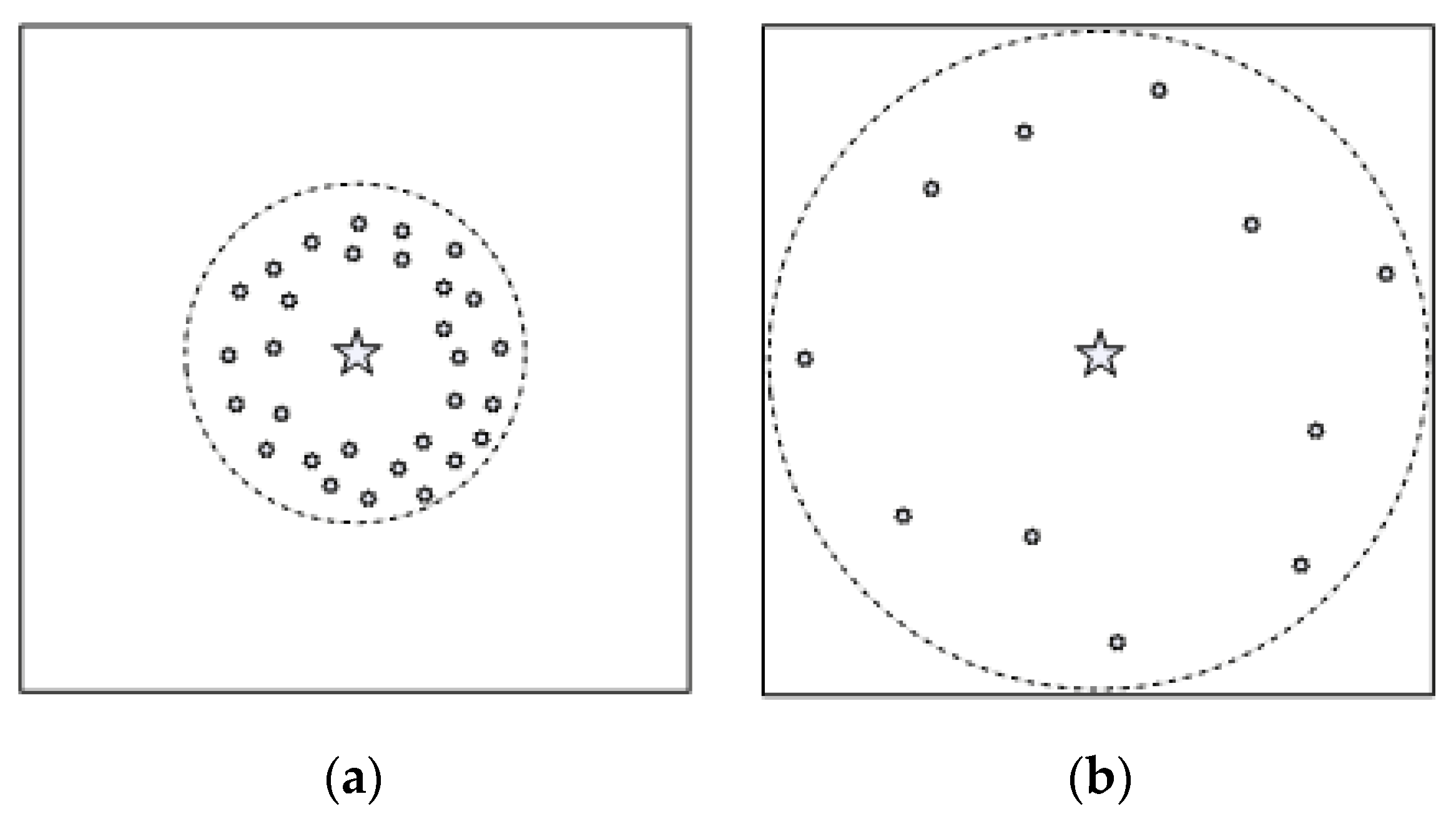
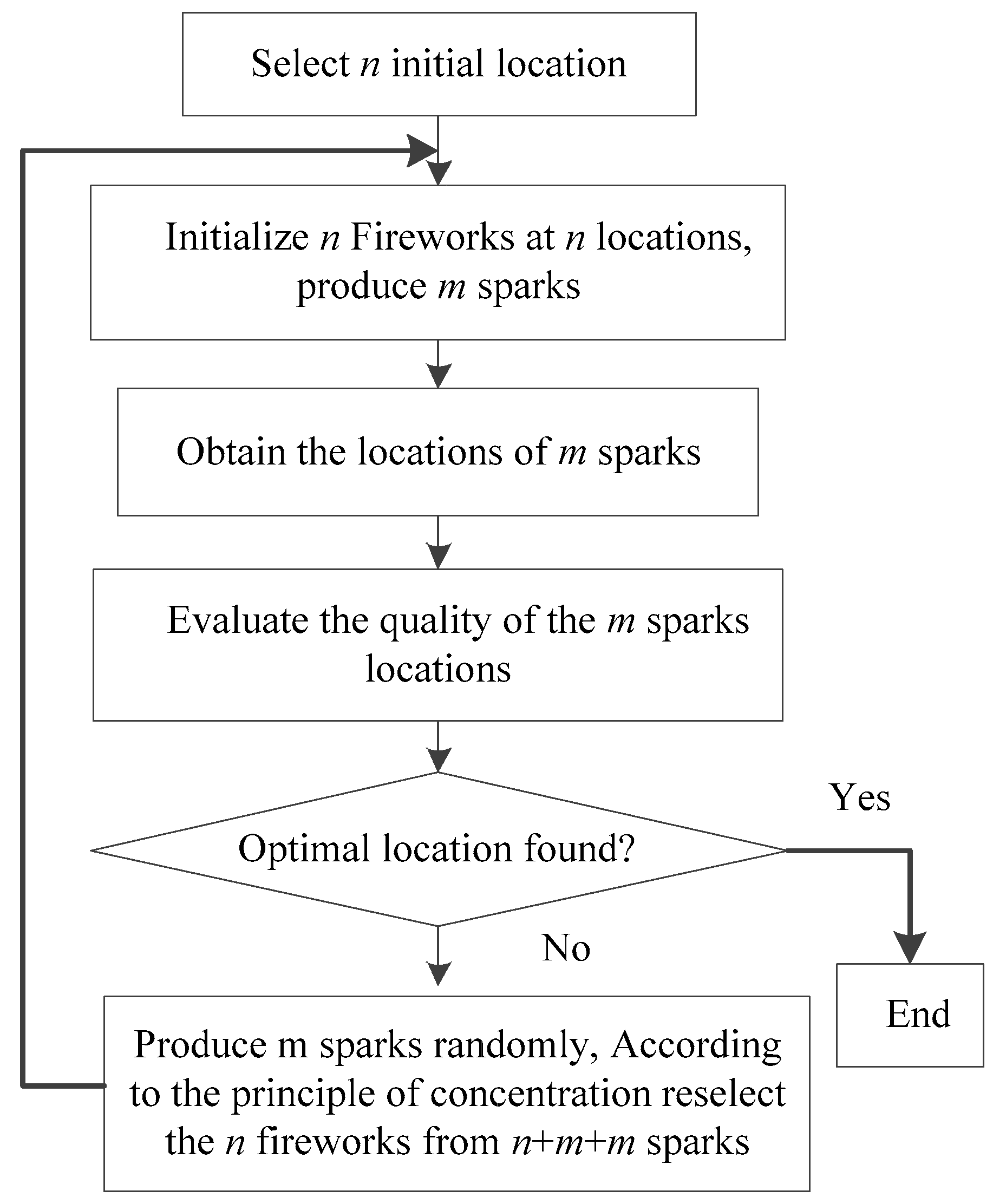
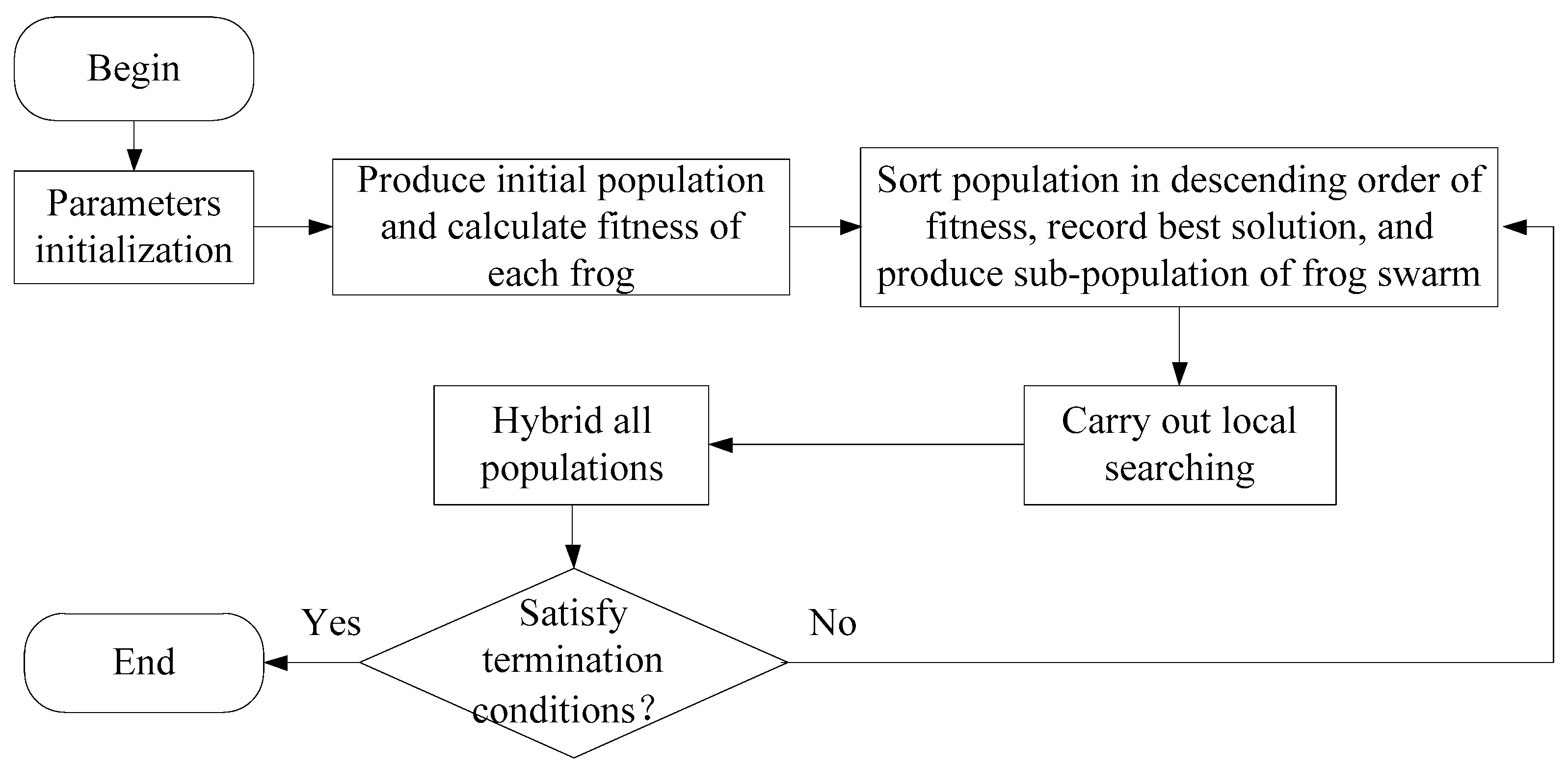
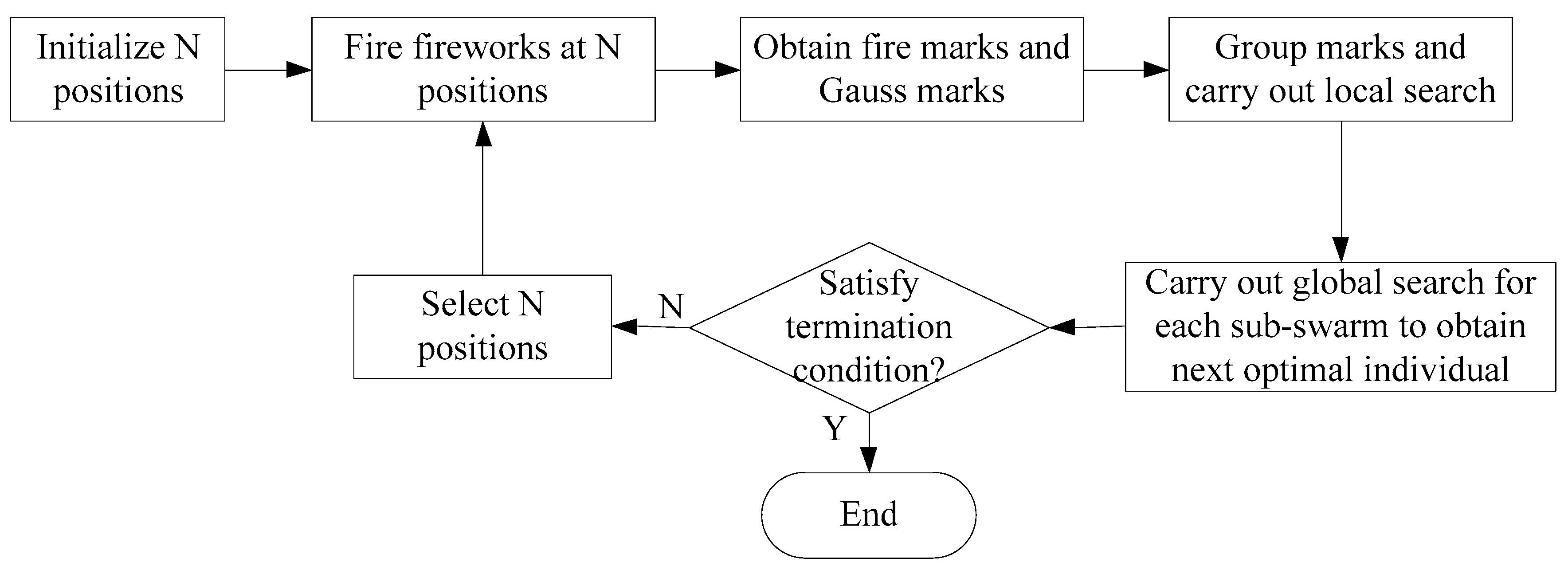
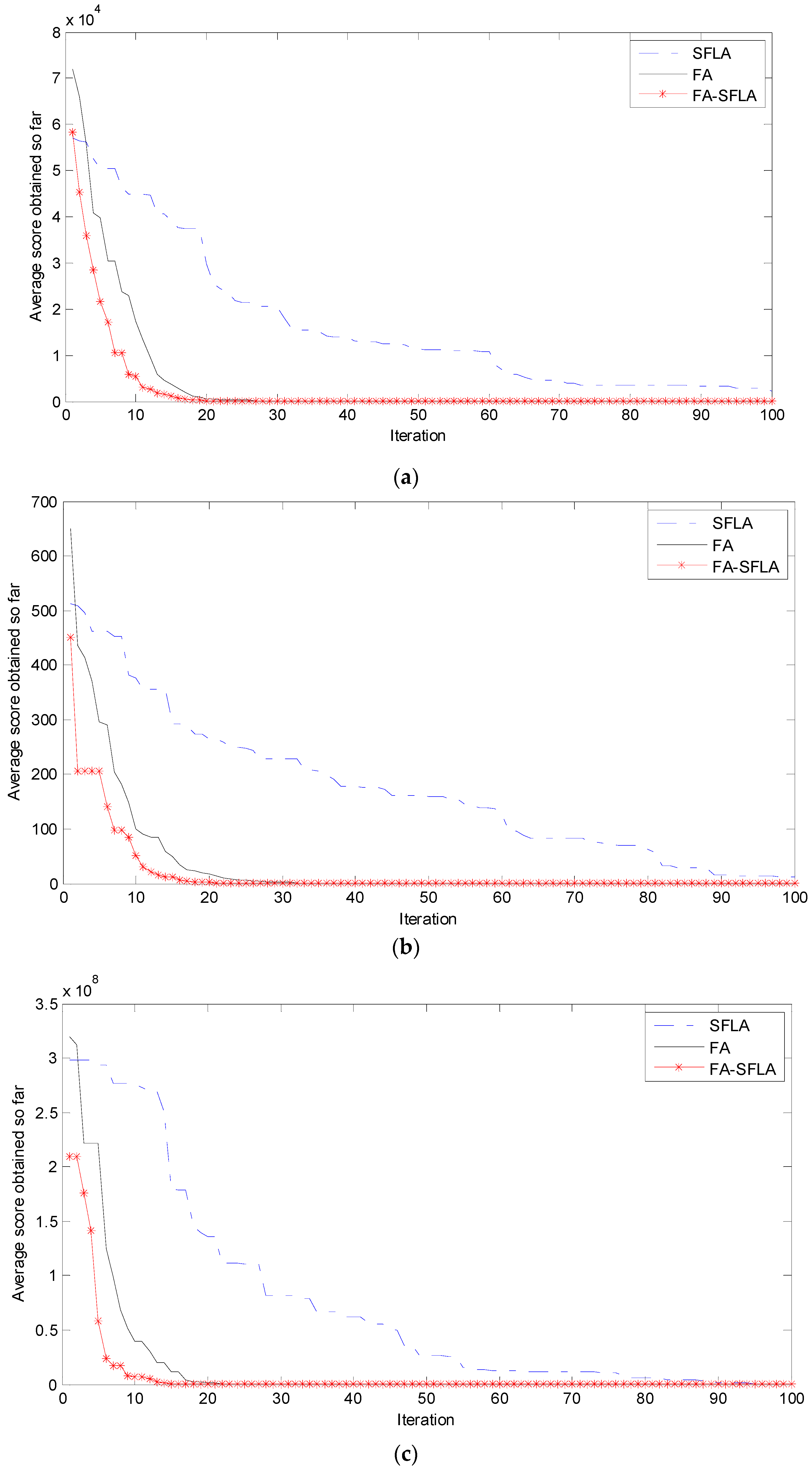
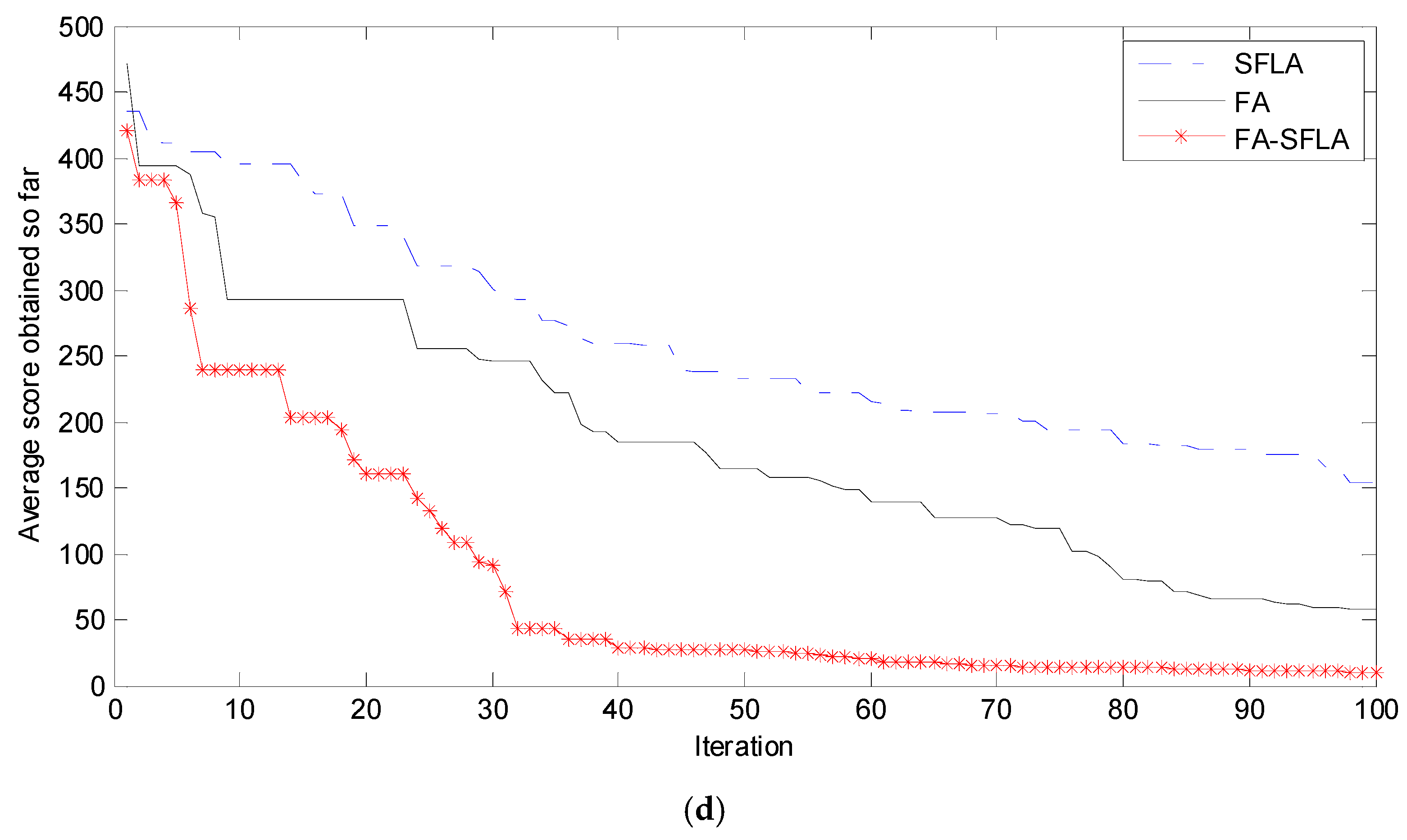
| Function Name | Expression | Scope | Dimension |
|---|---|---|---|
| F1 Sphere | [–100,100]n | 30 | |
| F11 Griewank | [–32,32]n | 30 | |
| F5 Rosenbrock | [–30,30]n | 30 | |
| F9 Rrastrigin | [−5.12,5.12]n | 30 |
| Parameters Set-Up of FA and FA-SFLA | Parameters Set-Up of SFLA | ||
|---|---|---|---|
| Parameter | Value | Parameter | Value |
| Number of fireworks | 8 | Number of population grouping | 8 |
| Number of offspring | 64 | Number of frogs in each group contains a number of frogs | 12 |
| Dimension of optimized problem | 30 | Iteration number in inner group | 15 |
| Number of maximum iterations | 100 | Maximum step-length | 100 |
| Number of maximum evaluations | 10,000 | Amount of total population evolution | 10,000 |
| Coefficient factor | 1.5 | Dimension of optimized problem | 30 |
| Function | Algorithms | Average Cost Function | Standard Deviation |
|---|---|---|---|
| Sphere | FA | 2.62 × 10−18 | 8.75 × 10−19 |
| FA-SFLA | 1.38 × 10−30 | 5.21 × 10−30 | |
| SFLA | 8.25 × 10−14 | 6.73 × 10−14 | |
| Griewank | FA | 0.006437 | 0.008332 |
| FA-SFLA | 0.000352 | 0.002783 | |
| SFLA | 0.02414 | 0.03564 | |
| Rosenbrock | FA | 35.65643 | 15.53476 |
| FA-SFLA | 28.54633 | 0.84352 | |
| SFLA | 58.23524 | 46.23514 | |
| Rrastrigin | FA | 3.84563 | 2.45623 |
| FA-SFLA | 0 | 0 | |
| SFLA | 45.43652 | 13.32451 |
© 2016 by the authors; licensee MDPI, Basel, Switzerland. This article is an open access article distributed under the terms and conditions of the Creative Commons by Attribution (CC-BY) license (http://creativecommons.org/licenses/by/4.0/).
Share and Cite
Sun, Y.-F.; Wang, J.-S.; Song, J.-D. An Improved Fireworks Algorithm Based on Grouping Strategy of the Shuffled Frog Leaping Algorithm to Solve Function Optimization Problems. Algorithms 2016, 9, 23. https://doi.org/10.3390/a9020023
Sun Y-F, Wang J-S, Song J-D. An Improved Fireworks Algorithm Based on Grouping Strategy of the Shuffled Frog Leaping Algorithm to Solve Function Optimization Problems. Algorithms. 2016; 9(2):23. https://doi.org/10.3390/a9020023
Chicago/Turabian StyleSun, Yu-Feng, Jie-Sheng Wang, and Jiang-Di Song. 2016. "An Improved Fireworks Algorithm Based on Grouping Strategy of the Shuffled Frog Leaping Algorithm to Solve Function Optimization Problems" Algorithms 9, no. 2: 23. https://doi.org/10.3390/a9020023
APA StyleSun, Y.-F., Wang, J.-S., & Song, J.-D. (2016). An Improved Fireworks Algorithm Based on Grouping Strategy of the Shuffled Frog Leaping Algorithm to Solve Function Optimization Problems. Algorithms, 9(2), 23. https://doi.org/10.3390/a9020023





